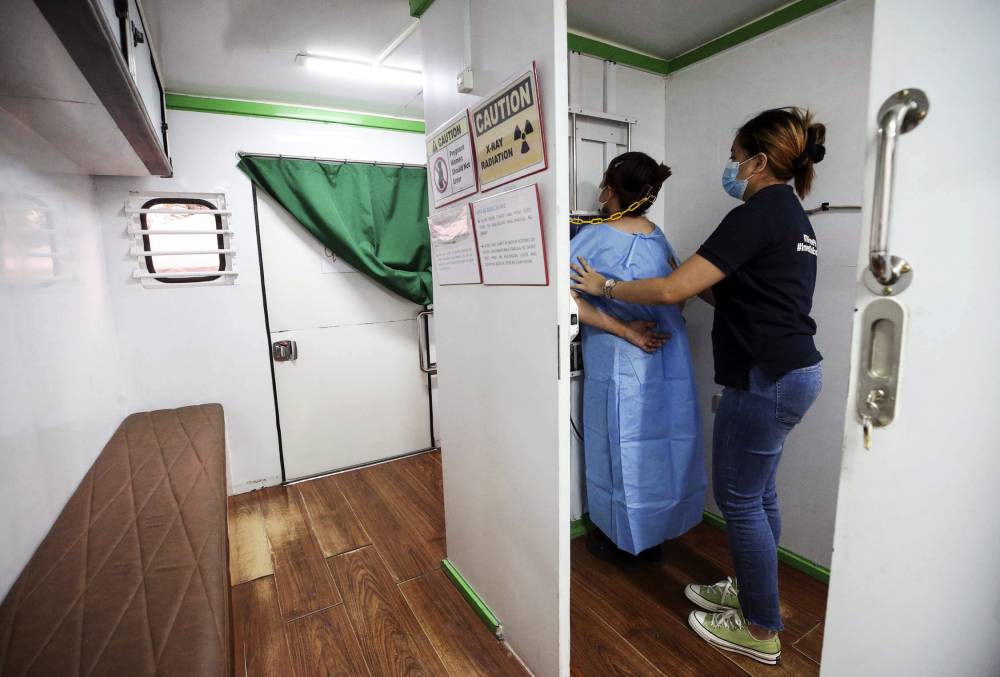
MONITORING A patient undergoes a free chest X-ray during a national health fair led by the Department of Health in March. An artificial intelligence tool in the X-ray machine helps detect tuberculosis. —LYN RILLON
At 24, Eloisa Zepeda Teng began her career as an architect. In 2006, she was diagnosed with tuberculosis (TB).
During her six-month treatment, she lost her sight. Her doctor said she had multidrug-resistant TB.
Teng struggled with loneliness and stigma, alongside the harsh treatment side effects of taking numerous drugs and daily injections.
One of her relatives, she said, blamed the ailment on her being a “bad person.”
It came to a point that she started looking for ways to end her “miserable life,” Teng said. It took her family’s strong support, two years of taking the right combination of anti-TB drugs and medication for anxiety and depression, and counseling sessions to pull her out of that dark place.
Success story
Now 41, Teng is doing well. Aside from earning a master’s degree in public policy abroad, getting married and having two children, she has collaborated with different international organizations, and this led her to establish TBPeople Philippines.
The nonprofit aims to overcome the stigma associated with the highly communicable airborne disease and spare TB patients from negative experiences brought about by discrimination.
Teng’s success story has inspired governments and civil society organizations to reach out to the more than 10 million TB sufferers in the world through TB-Mind Asia, or the Tuberculosis-Mental Health Integration Initiative Development-Asia.
Launched on Friday, the three-year project funded by the United States Agency for International Development hopes to integrate mental health-care management with TB treatment through a regional collaborative framework among national and local governments, medical groups, civil society and grassroots communities.
In the Philippines, the project will be implemented among TB patients in Parañaque and Batangas cities, with nonprofits Asia Society for Social Improvement and Sustainable Transformation and Yayasan Project Hope as partners.
PH cases rising
Starting off with the Philippines, Indonesia and Cambodia for its pilot implementation, the project can eventually be adopted and scaled up in different countries and health-care settings.
By 2027, it sees itself as a guide in crafting national policies and guidelines on improving mental health-care interventions with routine TB treatment.
The three Southeast Asian countries chosen for the project account for 45 percent of new TB patients in the world, according to the World Health Organization—with Indonesia and the Philippines occupying the first and fourth slots, with an incidence rate of 27 and 7 percent, respectively.
Such figures represent more than a third of the world’s TB burden.
For all its goal of reducing and ultimately eliminating the disease by 2035, the country is actually seeing an increase in TB cases, noted Health Secretary Teodoro Herbosa.
In 2023, new and relapse TB cases totaled 612,534, which translate to a case notification rate (CNR) of 549 cases per 100,000 people—higher than the 2022 CNR of 439 per 100,000.
Respiratory TB is the ninth cause of death in the Philippines, with more than 17,000 people dying from it last year.
Pulmonologist Nina Beltran-Yap said in a panel interview: “As clinicians faced with a TB patient, we focus on the management, diagnosis and treatment of the disease.”
Anxiety, depression
Yap also acknowledged that doctors have failed to give enough attention to the mental health aspect of treating TB.
Recent studies show that TB patients are three to six times more likely to contract mental health disorders—particularly anxiety and depression, or even psychosis—compared to those free of the disease.
“This is like a copandemic, similar to people living with HIV (human immunodeficiency virus) [being] more likely to become sick with TB,” Yap said.
Fear and the stigma of being seen as an undesirable member of a community are among the factors that lead to TB patients developing depression and anxiety.
Some of them even seek treatment at health centers outside their barangay to avoid being recognized and ostracized by neighbors, Herbosa said.
With the highly contagious disease likely to infect close members of the family, TB patients need to be isolated while undergoing treatment—a problem during the pandemic lockdown that prevented them from stepping out to continue their treatment.
This has put them at risk of developing drug-resistant TB.
Adding to the depression is the patient’s need to take out loans to cope with the cost of treatment. A 2022 study indicated that TB patients incur some P30,000 in out-of-pocket expenses despite free TB services from the government.
Then there’s the social and mental cost of isolating the patient, further straining family relationships.
“Patients therefore have less health-seeking behavior for the diagnosis and treatment of TB,” Yap pointed out.
“It becomes a vicious cycle: TB predisposes a patient to mental health problems, [which] predispose a patient to lack motivation, have low self-esteem and appetite loss, among other things, making the patient more susceptible to TB infection,” she added.
Support system
A strong support system—usually family, friends or significant others—will make the TB patient recover faster, neurologist-psychiatrist Joseree Ann Catindig said.
READ: DOH raises alert on rise in tuberculosis cases: It’s ‘higher than in 2022’
“Health information is important not only to the patients but to their support system,” she said. “We, as doctors, should not only be talking to the patients [but] make sure [they] understand that whatever the members of the support system are doing, they are doing it with them.”
“After all, these support systems do more than doctors in treating TB patients. Doctors are there for the patient for a few hours a month, but their support system will be there for them all the time,” Catindig said. INQ
READ MORE: DOH raises alert on rise in tuberculosis cases: It’s ‘higher than in 2022’